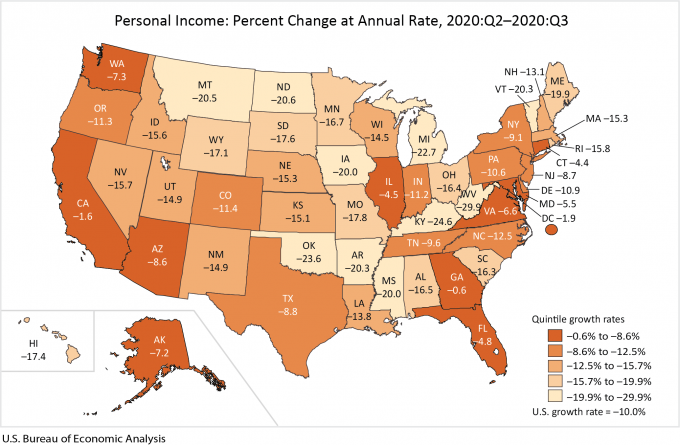Arizona Has Replaced 68.3% of the 294,600 Jobs Lost February to April this year
 By George Hammond, EBRC director and Eller research professor
By George Hammond, EBRC director and Eller research professor
Arizona added 6,500 jobs over the month in November (seasonally adjusted), according to the latest employment situation release from the U.S. Bureau of Labor Statistics. That was close to the average over-the-month job change during the 2015-2019 period, but significantly slower than October.
Arizona has now replaced 68.3% of the 294,600 jobs lost from February to April. That was better than the national replacement rate of 55.6%. Arizona jobs are still 93,400 below February.
Since June, Arizona’s over-the-month job growth has averaged 12,600. At that pace, it will take eight months for the state to regain its February employment level.
Most of the jobs added over the month in November were in transportation and warehousing, followed by leisure and hospitality. Professional and business services; government; other services; and information lost jobs.
As Exhibit 1 shows, job growth has been uneven across the state’s metropolitan areas. Jobs in Flagstaff are still 17.4% below February, while jobs in Prescott (-0.3%) and Sierra-Vista Douglas (-1.4%) have nearly recovered. In November, jobs in Phoenix and Tucson were 2.9% and 4.1% below February, respectively.
Exhibit 1: Nonfarm Payroll Jobs in Arizona’s Metropolitan Areas, Percent Change from February 2020, Seasonally Adjusted

The Arizona unemployment rate fell slightly in November, to 7.8% from 7.9% in October (seasonally adjusted). Arizona’s rate was above the national rate of 6.7%.
Arizona’s personal income growth hit the brakes in the third quarter, reflecting the timing of fiscal stimulus from the CARES Act. The massive economic impact payments (one-time Recovery Rebates) occurred in the second quarter.
As Exhibit 2 shows, Arizona’s personal income declined at an annual rate of 8.6% from the second quarter to the third. Even so, that was better than the U.S. and many states. (Release available here). https://www.bea.gov/data/income-saving/personal-income-by-state
Exhibit 2: U.S. Personal Income Growth by State, Annualized Percent Change from the Second Quarter of 2020 to the Third Quarter

Arizona’s personal income rose 9.7% over the year in the third quarter, down from a revised increase of 13.4% in the second quarter. U.S. personal income rose by 7.1% over the year in the third quarter.
As with the second quarter, transfer receipts rose significantly over the year in the third quarter, with a 35.4% gain. That followed a 67.1% increase in the second quarter. The increase in transfer receipts over the year, driven primarily by the CARES Act, accounted for 72.3% of the overall increase in personal income over the year in the third quarter.
Net earnings by place of residence rose by 5.2% over the year in the third quarter, up from 0.4% in the second quarter. Net earnings accounted for 32.3% of the over-the-year increase in personal income in the third quarter.
Income from dividends, interest, and rent fell by 2.3% over the year in the third quarter, which followed a 1.2% decline in the second quarter.
The Arizona Office of Economic Opportunity has released population estimates for July 1, 2020. The estimate that Arizona’s population was 7,294,587, up by 105,567 from July 1, 2019. That translated into a 1.5% increase, down slightly from 2019 growth of 1.6%. Phoenix MSA population was estimated at 4,907,152 on July 1, 2020, up 84,107 from last year (+1.7%). Tucson MSA population was estimated at 1,052,375 on July 1, 2020 a 0.7% increase from last year (+7,700).
 Curtis Holbrook joins SLC as Senior Superintendent, Ground-Up Construction Division
Curtis Holbrook joins SLC as Senior Superintendent, Ground-Up Construction Division Tucson, AZ – Tucson Museum of Art and Historic Block (TMA) celebrates a century of American Realism in The Wyeths: Three Generations | Works from the Bank of America Collection. The exhibition is scheduled to open on January 21, 2021 and run through May 9, 2021.
Tucson, AZ – Tucson Museum of Art and Historic Block (TMA) celebrates a century of American Realism in The Wyeths: Three Generations | Works from the Bank of America Collection. The exhibition is scheduled to open on January 21, 2021 and run through May 9, 2021.